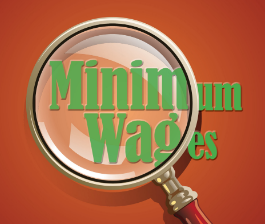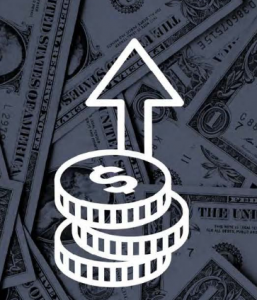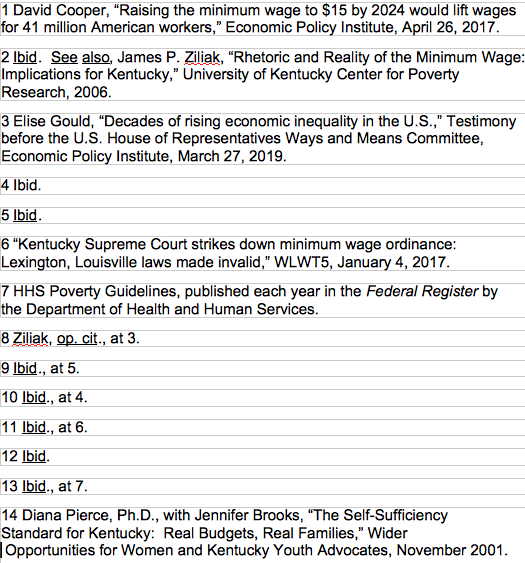Henry Ford once said, when asked why he paid his workers so well, “so they can buy the cars they make.” He recognized that a robust market for goods and services requires consumers with the means to purchase them.
The minimum wage is the single most effective public policy for ensuring that low-wage employers compensate employees more adequately. It also helps to undergird our economy, which is 70% dependent on consumer spending.
The minimum wage was enacted in 1938 as part of the New Deal. The initial level was $.25 per hour – over $4 in today’s dollars. It increased in value until 1968, when it reached $10 in real dollars, 99% of the poverty level. It then began to erode. Since 1989 it has averaged 60% of poverty.(1) Today’s level of $7.25 yields an income of $15,000 – 62% of poverty.

Until 1968 the minimum wage kept pace with rising productivity. Since then it has remained stagnant while productivity has continued to rise (2). Productivity grew six times faster than hourly compensation between 1979 and 2017.(3)
Twenty-one states have adopted minimum wage levels above the federal level, thirteen in 2018 alone. Eight indexed it to inflation.(4) Wage growth in the 10th percentile, the bottom of the income scale, has been 50% greater in those states than in states that have not raised their level.(5)
Kentucky has not adopted a higher state minimum wage. Lexington and Louisville adopted higher levels for their jurisdictions, but they were invalidated by the Kentucky Supreme Court in 2017.(6)
Most thoughtful people agree that full-time workers should earn more than the poverty level. A family of four today would require a wage of $12.50. (7)
Proponents of the minimum wage argue that it provides a higher standard of living and quality of life for workers and their families, that it helps them escape from poverty, and that it improves the economy by pumping in their additional earnings.
Opponents argue that minimum wage jobs are generally held by non-poor teenagers, that increasing it results in job losses, and that it is inflationary.
Let’s examine these arguments.
Making more money for performing a job obviously improves the standard of living and quality of life for a worker and family. Not every minimum-wage worker lives in a poor family. Some are middle-class teenagers. But over 70% are adults in low-income families, and the majority are parents.(8) Minimum wage increases directly improve their incomes.
Whether increases help families escape poverty is a more difficult question. Wage increases do not impact poverty for middle-class teenagers. The current minimum wage is so far below the poverty level that typical incremental increases do not lift families out of poverty.(9) Increases do improve their status in poverty.

Opponents argue that minimum wage jobs are generally held by non-poor teenagers. As shown above, only 30% of earners are teenagers. And only half of those live in non-poor households.(10)
Opponents argue that minimum wage increases cause job loss. Economists find that while increases do reduce employment, their impact is minimal. A 10% increase in the wage reduces employment 1%. (11) The U.K. Center for Policy Research notes the dynamism of the Kentucky economy, constantly creating and destroying jobs. It easily absorbs the effect of increases.(12)
Finally, opponents argue that minimum wage increases cause inflation.
Although not heavily studied, existing research confirms that the effect is, like that on job loss, small. A 10% increase in the wage results in a 0.4-0.7% increase in restaurant prices, and a 1.5% increase in fast-food prices.(13) These effects are of little economic consequence.
The relationship between poverty and the unemployment rate is unclear.
Kentucky has a high poverty rate, over 18%, while its unemployment rate is low, 4.9%. The question is, how much does the poverty rate reflect people working at below-poverty wages versus people who do not work, most for legitimate reasons, disabilities, chronic health conditions, caring for family members, lack of education, skills, etc.
Kentucky’s poverty rate, while high, does not accurately measure the costs for meeting basic needs. Research shows that the amount required is over 200% of the poverty level.(14)
How do families survive when working does not provide enough money?
Public benefits, paid for by taxpayers. Food Assistance, Medicaid, Earned Income Tax Credit, Child Care Assistance, and others. While essential, these benefits are hard to get and keep, because of complicated rules. They are so stigmatized that many eligible people do not access them, despite great need. And they are not flexible. If one needs tires for her car, Food Assistance does not help.

To identify these limitations of public benefits does not diminish their importance. The gap between need and income will not be bridged by increased wages alone. The long-term effects of globalization, mechanization, automation, and other changes in our economy mean there will be a continuing need for government intervention in the economy.
The minimum wage should be increased to $12.50 per hour and indexed for inflation. While only one step in addressing the problem of income inadequacy, it is a critical one.
Col Owens is a retired attorney. He teaches Poverty Law at NKU’s Chase College of Law.


















Our Legislature should address this problem immediately instead of spending all their time attacking women’s reproductive rights, encouraging doctor’s to discriminate against their patients and mandating which restrooms kids should use.